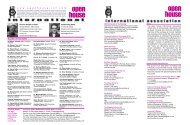Vol :37 Issue No.1 2012 - Open House International
Vol :37 Issue No.1 2012 - Open House International
Vol :37 Issue No.1 2012 - Open House International
Create successful ePaper yourself
Turn your PDF publications into a flip-book with our unique Google optimized e-Paper software.
Figure 1. Location of Phumolong informal settlement within Mamelodi and distances from critical services.<br />
have been relocated and the land developed for<br />
new government-subsidised housing – also referred<br />
to as RDP houses (from the Reconstruction<br />
Development Programme) or “give-away” houses<br />
(alluding to the fact that owners do not have to pay<br />
or pay a minimal amount). Currently, the South<br />
African government aims to provide formalised<br />
housing and services to these informal communities.<br />
However priority is given to the informal settlements<br />
“of the most vulnerable and disadvantaged<br />
groups” (UN-Habitat, 2003:129) and those established<br />
during the apartheid regime and pre-1994<br />
(Metroplan, 2006), thus excluding the specific site<br />
under investigation due to its recent establishment,<br />
after 2003.<br />
THE SITE: PHUMOLONG<br />
Phumolong is located in ward 16, extension 6,<br />
Mamelodi, Tshwane, South Africa at coordinates<br />
25° 44’00” S 28° 25’00” E. It is almost completely<br />
surrounded by the township of Mamelodi (Figure<br />
1) except to its south where the municipal boundaries<br />
of the City of Tshwane and Metsweding meet<br />
(both situated in the province of Gauteng).<br />
‘Phumolong’, Sotho for ‘resting place’, is<br />
the local name for this land which is occupied<br />
entirely by informal settlers’ shacks with almost no<br />
municipal services provided. The area of<br />
Phumolong is located along the curved main road<br />
of Hans Strijdom (M10) defining both its Northern<br />
and Western boundary while two converging railway<br />
tracks demarcate its Eastern and Southern limits<br />
(Figure 1). This area is locally referred to as<br />
‘bridge to bridge’, referring to the proximate infrastructure,<br />
and is managed by a community elected<br />
ward leader and committee. The older neighbouring<br />
community to the North-West, known as<br />
Marabastad by the locals, also belongs to<br />
Mamelodi Extension 6 and boasts RDP housing<br />
together with the necessary infrastructure. Electricity<br />
is extended from neighbours by means of illegal<br />
‘izinyoga’ (Sotho for ‘snake’) connections. Hose<br />
pipes are connected to garden taps within the<br />
neighbouring Marabastad and transverse the dividing<br />
asphalt roads. Hose pipes meander down the<br />
gravel roads serving the community of Phumolong,<br />
sometimes unseen but mostly overlooked by the<br />
municipality.<br />
Mamelodi does not have a fire station<br />
despite high rates of fire. Apparently, Mamelodi has<br />
7 5<br />
open house international <strong>Vol</strong>.<strong>37</strong> <strong>No.1</strong>, March <strong>2012</strong> Environments of change: an <strong>Open</strong> Building approach... Donovan Gottsmann and Amira Osman





